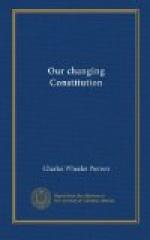In the early days of the Republic the dominating purpose was the protection of state prerogatives, so far as that was compatible with the common safety. The first eleven amendments of the Federal Constitution were all limitations upon federal power. Not until the people of the various states had been drawn together and taught to think in terms of the nation by a great Civil War was there any amendment which enlarged the powers of the National Government. The three post-war amendments (Nos. XIII, XIV, and XV) marked a distinct expansion of federal power but one that seemed to find its justification, as it found its origin, in the necessity for effectuating the purposes of the war and protecting the newly enfranchised Negroes.
A long period of seeming inactivity, more than forty years, elapsed before another constitutional amendment was adopted.[1] The inaction, however, was apparent rather than real. As matter of fact, a change was all the time going on. In a very real sense the Constitution was being altered almost from year to year. That the alterations did not take the shape of formal written amendments was largely due to the tradition of constitutional immobility. The idea had grown up that the machinery of amendment provided by the Fathers was so slow and cumbersome that it was impossible as a practical matter to secure a change by that method except under stress of war or great popular excitement. That idea is now exploded. We of to-day know better, having seen the Income Tax Amendment (No. XVI), the Election of Senators by Popular Vote Amendment (No. XVII), the Prohibition Amendment (No. XVIII), and the Woman Suffrage Amendment (No. XIX) go through within a period of seven years. For generations, however, the tradition of constitutional immobility held sway and the forces of change worked through channels that seemed easier and less obstructed.
[Footnote 1: No. XVI, the Income Tax Amendment, ratified in 1913.]
The principal channel has been congressional legislation. Congress has found ways of reaching by indirection objects which could not be approached directly. Under the express grants of power contained in the Constitution statutes have been enacted which were really designed to accomplish some ulterior object. A striking example is found in the child labor laws, discussed more at length in a subsequent chapter. Congress at first sought to regulate child labor by a statute enacted ostensibly as a regulation of commerce under the Commerce Clause of the Constitution. The Supreme Court held the Act unconstitutional as exceeding the commerce power of Congress and invading the powers reserved to the states.[1] Thereupon Congress practically reenacted it, coupled with a provision for a prohibitive tax on the profits of concerns employing child labor, as part of a revenue act enacted under the constitutional grant of power to lay taxes.[2]
[Footnote 1: Hammer v. Dagenhart, 247 U.S., 251.]




